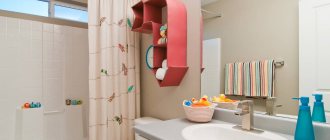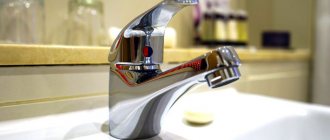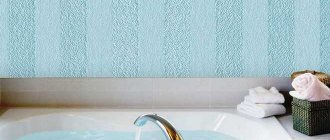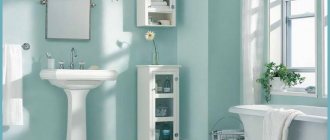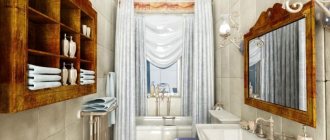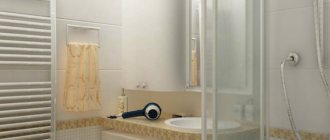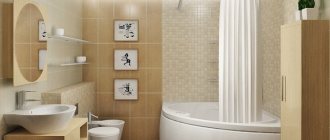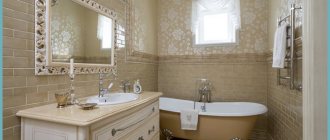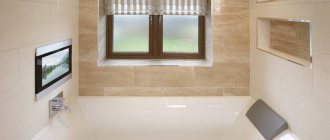Indoor plants occupy a special place in the interior, and their placement in the bathroom allows you to create a special atmosphere. The disadvantage of this room is low access to sunlight. It is important to choose the right plants for a bathroom without a window so that they can grow even in the presence of only artificial lighting.
Benefit
It is important to remember that plants in a bathroom where there is no window not only convey an aesthetic message, but also bring undeniable benefits:
- in addition to the ability to release oxygen, thereby purifying the air, the flora in the bathroom prevents the formation of fungal formations, normalizes the microclimate, improves water and gas exchange, and absorbs microparticles of heavy metals;
- flowers, with their natural aroma, deodorize the air in a room with or without a window;
- living indoor greenery is a pleasant reminder of summer and helps improve your mood;
- Flora plays an important role in the interior, making it colorful and complete.
From all of the above, the question arises: “can living vegetation grow normally and exist in a bathroom that does not have windows - they can.” There are varieties for which such conditions are the most acceptable and the absence of a window will not be an obstacle to their daily delight with their magnificent view.
Heart-shaped philodendron
These plants are ideal for bathrooms. You probably already know that the philodendron is a popular houseplant as it is easy to care for and looks great in hanging baskets or planters, making it an ideal choice for small spaces such as bathrooms. Philodendron also enjoys irrigation, so the steam from the shower will encourage its growth.
Requirements for plants
Bathroom varieties must have the following characteristics:
- love moisture, warmth;
- not demanding on light;
- should be in harmony with the interior.
In order for bathroom plants to feel good, form, and grow in a humid and warm atmosphere, you need to not only keep them there, but also properly care for them, especially since bathrooms often do not have windows.
Properly lighting the bathroom
For artificial lighting of the bathroom, you can use ordinary fluorescent lamps or special phytolamps. The latter are used by professional gardeners for lighting in greenhouses.
Installing phytolamps is a more expensive option, but they emit light at the frequency required by the flowers, so they are more able to compensate for sunlight.
When choosing a phytolamp, you should pay attention to the following varieties:
- Luminescent - they emit cold light, do not heat up and last a long time. The only negative is that flowers that prefer dim light must be placed at a distance of more than 50 cm from the lamps.
- Metal halide lamps have a radiation spectrum that is comfortable for any color, do not burn out for a long time, but are expensive.
The number of lamps and the intensity of the glow are adjusted depending on the number of potted flowers. The more plants there are in the room, the more powerful the lamps should be.
A good solution would be to illuminate the bathroom using LED lamps. They emit soft, diffused light and allow you to highlight flowers even in the most remote corners.
Flowers for a bathroom without windows
Aloe vera
For a windowless bathroom this is an ideal candidate. Large amounts of sunlight are contraindicated for this plant, as it can get burned. Of course, this does not mean that it needs to be kept in complete darkness. Additional illumination of aloe is necessary, like other green inhabitants of the bathroom.
It should be watered rarely, but thoroughly. You need to let the soil dry out between waterings. This will help avoid root rot. In general, this flower is very tenacious, and in order to ruin it, you have to try very hard.
It is worth noting that aloe vera is also a medicinal plant. Leaf juice accelerates wound healing. You can also wipe the skin on the face and neck with pieces of leaves to preserve beauty and youth.
Dieffenbachia
Dieffenbachia is a popular indoor plant, which has more than 60 varieties. A flower with beautiful variegated leaves refreshes the room and gives it coziness. With it you can create a real exotic corner indoors.
Dieffenbachia grows to a height of 1.5 m. For the bathroom you need to choose low-growing plant varieties. For example, the Bauze variety with a dense trunk, light green leaves reaching up to 40 cm in length, is excellent for arranging a tropical corner in the bathroom.
Dieffenbachia should be grown in light soil that drains moisture well. For planting, it is recommended to choose soil that contains peat. It is imperative to make drainage at the bottom of the pot so that stagnation of moisture does not destroy the plant. Dieffenbachia does not require complex care and constant daylight. It will tolerate even a long absence of watering.
Moss terrarium
You can create a small terrarium for the bathroom in a transparent glass container by placing moss moss or sphagnum moss among the pebbles. Decorative moss does not tolerate direct sunlight. The terrarium will help to create an exquisite composition that will become a real highlight in the design of the bathroom.
Moss does not require special care; it is enough to water it once every 2-3 days with a spray bottle.
Dracaena
Very similar to chlorophytum, but has a stem. It loves a humid atmosphere, so you can often see dry tips on the leaves. It will feel great in a bathroom with high humidity. There are many varieties of this plant, and every gardener will be able to choose a specimen to suit their taste.
Due to its rapid growth, reproduction of dracaena at home occurs quickly. Most often, lateral or apical shoots are used for this, which take root in a week or two. But you can also use seeds.
Bamboo
This exotic plant can be grown as a decorative ornament even in the absence of lighting and soil! In order for the bamboo to feel comfortable, you need to place its root in a prepared pot, filling its bottom with pebbles. Then you should add water to the container and monitor it, it should stay at the level of half the pot.
Bamboo with climbing stems looks great in a bathroom; you can create original compositions with it.
Selaginella
This ground cover grass has very beautiful carved leaves that resemble lace. Selaginella is bush-like and is often given the shape of a ball, which looks very impressive in the interior. The plant is unpretentious, feels good in the shade and loves frequent spraying of the leaves and abundant watering. The soil in the pot should be loose.
Fern
In nature, the natural habitat of ferns is diffused light and high humidity. The bathroom has similar conditions, so this plant seems to have been created for this room. If under normal conditions it needs to be constantly irrigated, then in the bathroom it will grow and please the eye without much effort.
In addition, he is not picky and very handsome. All this makes him extremely popular.
However, when choosing a fern for the bathroom, it is worth considering that some varieties prefer lower temperatures.
No special care is required for this flower. The only condition is that the soil should always be slightly moist.
Chlorophytum
This spreading flower will probably never lose its popularity. It is low maintenance and very easy to grow. In addition, it perfectly cleans the air of harmful impurities, which are found in abundance in modern apartments, and saturates it with oxygen.
What makes chlorophytum an ideal resident for a bathroom is the fact that it loves high air humidity. Have you noticed dry, yellowed tips on the leaves? This is a result of dry indoor air.
He is not afraid of temperature fluctuations, indiscriminate watering, or poor lighting. Chlorophytum, like dracaena, reproduces easily at home. He constantly grows a mustache with new shoots at the end. You just need to plant it in a new pot and it will grow right away.
Begonia
Begonia has a wonderful decorative appearance due to its fleshy, juicy reddish leaves with light speckles. For the plant to grow comfortably, it needs fertilizer-rich, well-drained soil, which must be moistened as the earthen ball dries out.
Begonia tolerates humid air well, but direct contact with water on leaves and tubers can cause rotting, so watering must be done extremely carefully and it is preferable to pour water into the tray of the pot.
Sansevieria
Or “Mother-in-law’s tongue,” as it was popularly called for the shape and length of its leaves. For a comfortable life, this plant does not need much - a little light and the same amount of moisture. This is why Sansevieria is perfect for a bathroom without windows! Its unpretentiousness, originality and decorativeness make it very popular. Especially among lazy flower growers who do not have time or forget how to properly care for the flowers in the house. “Mother-in-law’s tongue” will tolerate the most careless attitude and, in spite of everything, will grow and please the eye.
Aspidistra
Aspidistra (snake sign) - from tropical forests, with long, smooth, stemless leaves. Does not require careful care; it will tolerate moisture stoically.
Aspidistra does not suffer from a lack or excess of moisture, so it will be comfortable in your bathroom
Cyperus
Gift of the river (cyperus in translation from Egyptian) like sedge prefers swampy soil and river banks. A wet bath for Cyperus is perfect. It is better to plant an attractive plant in a cluster, creating a green corner in the room. You just need to remember that Cyperus does not like cool air.
Hardy Cyperus is very popular
Aglaonema
This flower has spreading wide leaves that are distinguished by an unusual color: the veins can be colored in a palette from red to light yellow, which is its beautiful feature.
Aglaonema loves loose, moist soil and grows well in partial shade, so the bathroom is perfect for growing it.
Spathiphyllum
The large white inflorescences of spathiphyllum (popularly known as women's happiness) will enliven the monochromatic company of green inhabitants of the bath. This plant loves to spray its leaves, so it will take well to wet steam after bath procedures.
Spathiphyllum needs a light source.
Spathiphyllum plant: loves warmth, hates drafts
Nephrolepis sublime
This low-maintenance representative of ferns is often found in bathroom landscaping. But rooms with a window are more suitable for the plant - if there is a lack of daylight, nephrolepis will begin to shed its leaves. But it is not afraid of moisture and needs regular spraying. And once a week he will not refuse a warm shower under a weak stream of water that does not damage the shoots.
Philodendron
For this hanging plant, light is not as important as moisture. The soil in his pot should be constantly moist, but not too much. Due to its rapid growth rate, it is important to provide ample space for philodendrons. It can be safely used to create a newfangled decor - a green wall.
Monstera
One of the most favorite vines among gardeners. It is universal and non-capricious. The optimal temperature for its growth is 23–25 °C; if you raise the temperature, it will actively begin to grow. Monstera does not tolerate dry air and needs regular spraying and a humid atmosphere. She is able to predict the weather: if drops of water form on the leaves, then rain is quite likely outside. Beautiful feathery leaves grow only in partial shade or moderate light.
Ivy
It is classified as an unpretentious vine and is actively used in interior decoration. In his native subtropics, he is used to living in shady forests, so he will be quite comfortable in a dimly lit bath. But it will easily wither in the dry, hot air. Ivy is suitable for decorating top shelves and vertical gardening. The plant is considered one of the most effective air purifiers.
Orchid
The exotic plant attracts with its unusual flowering. The microclimate of the bathroom resembles the conditions of the tropics, which means that exquisite orchids will do well there. In a room without windows, you need to provide artificial lighting for them using a phytolamp. The flower does not require frequent watering.
General recommendations for growing
When choosing plants for the bathroom, you should remember that even the most moisture-loving people need fresh air. Good ventilation of the room is required to prevent rotting and fungal diseases. When humid air stagnates, mold appears in the bathroom, and powdery mildew appears on plants, which is very difficult to combat.
The temperature at which most green pets will be comfortable is 20 – 22°C.
As the leaves become dirty, they are wiped with a soft washcloth, and the plants are bathed with warm water from the shower.
In indoor conditions, moisture-loving house flowers need regular spraying, which takes a lot of time. High humidity in the bathroom allows you to do without these procedures.
The health and decorative appearance of indoor flowers largely depends on lighting and choosing the right place for each of them.
Plant placement ideas
The space of a standard bathroom is most often limited to a few square meters. Therefore, plant compositions should be as compact as possible. Designers offer several universal principles for arranging plants:
- Vertical space should be used as much as possible. The most popular option is hanging hanging plants. They can also “frame” a mirror by building a small shelf above it. On a free wall you can arrange a whole rack with flowerpots.
- It is better to place the heaviest pots with large plants on the floor in the free corners of the room.
- Lush, bushy plants look good on dressers and low cabinets, as well as on shelves above the front door.
- When creating compositions, low and most decorative specimens with beautiful leaves are placed in the foreground.
- Using mirrors is a win-win option, especially for a small bathroom. Placing pots of flowers opposite mirrors will create the illusion of increased space.
What not to do
The bathroom is a technical room, which, first of all, should be comfortable and safe. Hence the main rule: plants and people should not interfere with each other. That's why:
- Flower pots are not placed on the walkway.
- Large specimens are not grown in small spaces.
- Do not place containers on unstable surfaces (for example, washing machines) and carefully check the reliability of the fastenings of hanging flower pots.
- For hanging structures, it is better to plant plants not in ceramic pots, but in lightweight plastic ones.
- Do not place containers with plants where they can cause injury.
- Flowerpots should not be placed near heated towel rails or heating appliances.
Note: Drops of soapy water and splashes from cleaning products are dangerous for plants: they cause stains and burns on leaves and stems. When contacted with soil, such substances cause soil poisoning and can lead to the death of the root system. Therefore, flowerpots are not placed in the immediate vicinity of a bathtub or shower. During cleaning using cleaning products (especially from a spray bottle), flower pots are covered with protective material (paper, fabric, polyethylene) or transferred to a safe place.
Organization of lighting
Under natural conditions, plants absorb daylight selectively. For normal growth, they need light waves in the red, blue, violet and ultraviolet ranges of the spectrum. Very little yellow light is absorbed, and green light is almost completely reflected. This means that ordinary incandescent lamps are not suitable for illumination: their spectrum is dominated by waves in the green and yellow-red ranges, but does not contain the necessary blue color. Moreover, they are not economical.
The following types of fluorescent lamps operate in the most suitable ranges:
- LD – fluorescent lamps;
- LE – natural light lamps;
- LED lamps LED.
They are safe, economical and closely match the spectrum of sunlight, so they are optimal for use at home. A variety of LED lamps allows you to combine the illumination of plants with the design of the room.
Note: In recent years, phytoLEDs (phytolamps), usually two-color, have been actively used to illuminate plants. Their spectrum is indeed suitable for illuminating seedlings and flowers, but is extremely unfavorable for human vision. Therefore, in residential premises, phytolamps are used to a limited extent or are equipped with reflectors, which are purchased in specialty stores for plants or aquariums.
Rules for illuminating plants:
The duration of the “daylight hours” for shade-tolerant plants is 8–9 hours. During this time, the lamps must operate continuously, taking into account the following points:
- For shade-loving plants, the illumination height is 30 – 60 cm (depending on the needs of the plant).
- It is advisable to install the lamps directly above the plant, perpendicular to its surface. If the light source is placed at an angle, the stems and flowers will stretch in its direction.
- Lighting should be regular. The lamps are turned on at the same time every day, optimally in the morning at 7 - 8 o'clock. Violation of the regime leads to a disruption in the biorhythms of plants, which will inevitably affect their condition.
- At least occasionally, take the plants out into natural sunlight for a few days to allow them to gain strength.
The desired height of the light source can be set using adjustable pendant lights or lamps on tripods. Wall brackets are used to secure the lamp permanently. You can also come up with illuminated shelves.
If installation of additional lighting is possible only on the ceiling, then light loss should be taken into account, which is proportional to the square of the distance to the light source. It can be partially compensated. To do this, plastic or metal reflectors (reflectors) are installed on the body of the fluorescent lamp. These simple devices “collect” the light flux and orient it in a given direction (in this case, down).
For pendant lighting, light loss can be reduced using directional light fixtures. In this case, the function of reflectors is performed by open opaque lampshades.
Fluorescent lamp with reflector.
Good offers on phytolamps:
Calculation of lighting power using fluorescent lamps as an example
The required number of lamps is determined by the following parameters:
- luminous efficiency of a particular lamp (expressed in Lm/W and indicated by the manufacturer, excluding light loss);
- illuminated surface area;
- the needs of plants for a certain level of illumination (expressed in lux and for shade-loving plants is 5000 - 10000 Lux);
- height of the light source.
The procedure for determining the number of lamps with a power of 36 W and a luminous flux of 2500 lm to illuminate an area of 1 m² from a height of 30 and 60 cm:
- The luminous efficiency of the lamp is calculated from the ratio of luminous flux to power consumption: 2500: 36 ≈ 70 Lm/W.
- Luminous flux required by plants: 7000 Lux × 1 m² = 7000 Lux (since the surface illumination is uneven in any case, the average value of the required one is taken - 7000 Lux).
- Light loss at a height of 30 cm will be 30%, at a height of 60 cm – 50%. Thus, the luminous flux value should be increased by 30% (1.5 times) or 50% (2 times) for each case, respectively. 7000 Lm × 1.5 = 10500 Lm; 7000 Lm × 2 = 14000 Lm.
- Total lamp power in each case: 10500 Lm: 70 Lm/W = 150 W; 14000 Lm: 70 Lm/W = 200 W.
- 150 W: 36 W ≈ 4 pcs; 200 : 36 ≈ 6 pcs.
That is, for shade-loving plants occupying an area of 1 m² at a height of 30 cm, it is enough to install 4 fluorescent lamps with a power of 36 W. At a height of 60 cm you will need at least 6 of the same lamps. The specified parameters correspond to Osram brand fluorescent lamps with a length of 120 cm.
Knowing the power of the lamps, you can calculate the daily power consumption by multiplying 8 hours by 150 or 200 W. The result will be 1.2 kW and 1.6 kW per day, respectively, or 36 kW and 48 kW per month. Knowing the cost of electricity in your region, it is easy to calculate the monthly/annual costs for such lighting.
Proper placement and care of flowers
Any green plant needs light for life, because only in light does the formation of organic substances necessary for the plant organism occur.
Some species are content with a small amount of light energy and survive well in a shaded room.
How to care
There are a few rules to remember to make your living decor feel good:
- Place it away from heating radiators.
- Immediately remove traces of household chemicals that get on the leaves.
- Water your pet moderately and not too often, keeping in mind the high humidity.
- Without an additional source of light (lamp), the plants will survive for 6-8 weeks, but then it is strongly recommended to take the flowers out into the light so that they can recover.
- Get fluorescent lamps for illumination or a special phytolamp with a certain light spectrum that is optimal for indoor plants.
The atmosphere in the bathroom often resembles a dense tropical forest
Plant placement
In spacious rooms, flowers in tubs, flower pots, and fancy metal stands are placed directly on the floor, softening the corners of the room.
Thick dark greens look great against the background of light walls.
If the room is small, hanging plants are placed in flowerpots mounted on the walls in random order, on corner shelves, and on cabinets. Small pots can be placed on an undermirror shelf.
A side-loading washing machine will serve as a surface for a flower pot that can be placed on top of the household appliance.
Compliance with safety precautions when operating a household appliance is necessary!
When watering a flower on a washing machine, do not allow water to spill into the electrical part of the equipment, especially if it is running.
You should not place flowers on the edges of the bathtub, sink, or block access to places of constant use (shower stall, washbasin), or in places where detergent will constantly get on the leaves.
The choice of colors for a bathroom without a window should be approached with all responsibility.
Plants for a bathroom with a window
Spacious modern bathrooms today often feature a large window that provides plenty of light and fresh air. In such conditions, you can grow almost any plant, except, perhaps, those that cannot tolerate high humidity at all.
Thanks to good ventilation, there are no too sudden temperature changes in a bathroom with a window, water does not stagnate here, and mold and mildew do not develop. Therefore, such a bathroom is an almost ideal place for moisture-loving plants. Some species grow here even faster and better than in an ordinary room, for example, Dieffenbachia, Ficus, Cyperus.
IN THE PHOTO: A window sill in a bathroom with a window is an excellent solution for moisture-loving plants!
You can also keep many flowering plants in a bathroom with a window - Camellias, Hibiscus, Saintpaulia. However, when growing the latter, it is necessary to take into account that they do not tolerate direct moisture on the leaves, so these flowers should be placed away from the sink, bathtub or shower. Various types of palm trees (Hovea, Hamedorea) are suitable for a spacious bathroom, on the floor of which these plants can be placed in large tubs or pots.
Caring for plants in a bathroom with a window is almost the same as caring for those growing in other rooms. But due to the high humidity, the flowers here do not need spraying. And the plants are usually watered once a week, sometimes less often - as the soil dries out. If heated floors are installed in the room, the substrate dries out faster; in this case, the frequency of watering is increased.
Possible problems
Even if the bathroom contains unpretentious plants that are resistant to high humidity and low lighting levels, problems cannot be ruled out. Based on external signs, you can diagnose the cause of the plant’s ill health and take timely measures to save it.
| Problem | Signs | How to fix |
| Lack of light | Elongated stem and leaves New leaves grow dull and smaller in size The lower leaves dry out and fall off The apical buds do not develop Flowers or buds fall off Small, pale, dull flowers appear or there is no flowering at all. The plant stops growing. | Move the pot to a more illuminated place Install a source of artificial lighting (fluorescent lamps) in the bathroom |
| Excessive humidity | Brown spots on leaves | Select species that require high humidity or are resistant to it |
| Low room temperature | Brown spots on leaves | Select cold-resistant species |
| Insufficient watering | Leaves turn yellow | Regular watering |
| Lack of microelements | Leaves turn yellow | Fertilizer application |
Despite the special microclimate in the room for water procedures, it is possible to create a corner of nature in the bathroom.
Plants will add freshness to any bathroom and diversify the interior.
Properly selected plants that can adapt to high humidity and shade will create a mood, help you relax and clear the air of chemicals and bacteria. After studying the information in this article, everyone will be able to create their own little oasis.
Content
- 1. Plants for a bathroom with a window
- 2. If there are no windows in the bathroom
- 3. Caring for plants in a bathroom without a window
- 4. If additional lighting is not enough
- 5. Selection of plants for the bathroom interior
- 6. A few final tips
A bathroom decorated with flowers can be a great place to relax after a tiring day at work.
Indoor plants will make even a small standard bathroom more attractive. But not all flowers can grow in conditions of high humidity and lack of natural light. Additional sources of artificial light will help partially solve the problem. However, these measures are sometimes not enough to satisfy the needs of plants. Does this mean that landscaping a bathroom is an almost impossible task? It all depends on the size and some features of the room.
Varieties of phytolamps
There are several types of lighting lamps that have been developed for growing flowers indoors (greenhouses, at home) where there is little or no natural light. They must always be kept on. As a rule, phytolamps are placed around the perimeter of the bathroom at a distance of 30-45 cm from the plants.
The lamp is:
- luminescent – minimal heat and long service life (distance from flowers more than 50 cm);
- LED – has the maximum useful light flow for plants, has a soft effect (suitable for illuminating remote areas);
- metal halide - has high power and an optimal light spectrum, maximum resource reserve (disadvantage - high cost).
A few final tips
- For the bathroom, try to select plants from the tropics - they are usually more resistant to high humidity and lack of light.
- Do not place a large number of plants in the bathroom. In a small room, one large flower or two or three small ones is enough.
- Moderate watering will protect flowers from rotting roots. The humidity in the bathroom is already high, therefore, even moisture-loving species will need to be watered less often than usual.
- If cosmetics or household chemicals come into contact with the leaves of the plant, immediately wipe them with a damp sponge.
Placement of flowerpots
In addition to their beauty, plants can create certain inconveniences. To prevent this from happening, they need to be placed skillfully.
General recommendations:
- place flowerpots on flat surfaces;
- hanging varieties can be placed on the walls, so they will not interfere with the use of the bathroom or furniture;
- It is not recommended to place flowerpots near washbasins or shower stalls for two main reasons: first, they can be accidentally touched and knocked onto the floor, second, not all varieties like direct splashes on the leaves, base or stem;
- You should also not place flowerpots near heating radiators above the window;
- feed with granular fertilizer.
Some tips on how to place flowerpots, which ones should be placed where, so that they do not create inconvenience during use.
Floor
You can put tree-like varieties with lush crowns. They look very good in corners where various actions are performed minimally or very rarely. Various palm trees, tall, and not very lush plants are suitable for placement on the floor. To prevent plants from cluttering up space and passages, they should be placed in places that are practically not used for various types of activities. A place under the sink is perfect, but it is not recommended to place plants near the bathtub and shower stall, as they can be accidentally caught and damaged. When placed in this way, soapy water may get on the leaves of the plants, which will lead to their death.
Shelves
This piece of furniture is an excellent alternative to a window sill, this is especially true in bathrooms without windows, and you can hang them however you like: in steps or in a checkerboard pattern. Shelves are installed on free sections of the wall. Hanging flowers look wonderful on them, especially if they are also flowering plants.
To diversify the interior of the bathroom, you can arrange the shelves in a chaotic order and paint them in different colors. Try this method and your bathroom will sparkle in a completely new way. This is a great way to fill empty corners in a room. Ivy and climbing Philodendron are suitable for installation on shelves, and if the shelf is installed above a mirror, then these plants will look great hanging from it and framing the mirror.
Cabinets
If the rooms are small and have no windows, and it is not possible to install shelves, then it can be placed on a cabinet. In this case, it is better to choose ampere varieties of flowers. When choosing plants, consider the height of the cabinet; this determines whether small or large plants, hanging or upright growing, will look good on it. Whatever the size of the closet, there will definitely be room for beautiful plants and it’s worth taking advantage of it.
Cabinets
If the bathroom has a cabinet for linen, then this is the place where various plants will look good. Saintpaulias and Kalanchoes are suitable for any cabinet and can be placed in beautiful flower pots. But from time to time these plants will have to be taken out of the bathroom and their environment changed so that they do not die.
Lush bushes look colorful on a floor stand. Firstly, they serve as interior decoration, and secondly, they will help maintain order in the room, since this piece of furniture is often cluttered with various improvised items.
Bathroom vegetation without windows can exist normally if the basic requirements are met: know which varieties to choose, create the proper conditions to maintain their life support, and appropriate care. Therefore, acting wisely, you can decorate a bathroom without a window as you please, the main thing is that your landscaping and all the selected plants fit into the design project and bring maximum comfort and pleasure.
Sources
- https://VannayaSovety.ru/aksessuary/rasteniya-dlya-vannoy-komnaty.html
- https://podokonnik.temadnya.com/1445930917623236983/rasteniya-dlya-vannoj-komnaty-bez-okon/
- https://okna-dom.net/tsvety-dlya-vannoy-komnaty-bez-okon/
- https://pol-master.com/interesno/komnatnye-rasteniya-dlya-vannoy-komnaty.html
- https://bezkovrov.com/sanuzel/7-rasteniya.html
- https://www.InMyRoom.ru/posts/11428-obitateli-domashnih-tropikov-10-rasteniy-dlya-vannoy-komnaty
- https://yanashla.com/rejting-populyarnyh-komnatnyh-rastenij-vannoj-komnaty/
[collapse]
Selection of plants for the bathroom interior
When choosing colors, the size of the room is of great importance. For small rooms, hanging plants are ideal: Philodendron (as well as Scindapsus or Roycissus) or some types of Saintpaulia. They do not take up precious space on the floor and can be used to beautifully decorate walls or cabinets. If the space allows, then a tub with a large plant, for example, Ficus or Monstera, looks good on the floor.
IN THE PHOTO: In a spacious bathroom, a single plant in a floor container looks especially sophisticated
The design of the bathroom also plays an important role in the selection of plants. A pleasant contrast to walls lined with light-colored tiles will be created by specimens with dark, rich leaf colors. If wood predominates in the decoration or accessories, it is better to place palm trees or ferns with openwork foliage in the room.
Some plants can be placed in the bathroom temporarily, for example, only in the evening or during the flowering period. In the absence of direct sunlight, flowering continues for a longer period. After being in the bathroom, the pots are moved to a well-lit place and the flowers are provided with additional feeding.
Where to place the plants?
The smaller the bathtub, the more difficult it is to arrange plants so that they look beautiful. The easiest way is in a bathroom with a window - the window sill will be the best place there. But even in small rooms you can add flowers to the interior.
Walls can be used for hanging flowerpots with hanging flowers. Wall shelves are also a good option for placing both hanging and regular small plants. The bathroom design will become more interesting if you arrange the shelves in a checkerboard pattern. An ampel plant on a shelf looks good in the corner of the room.
IN THE PHOTO : Small plants in hanging pots can save space in the bathroom
The floor is a great place for tree-like plants, small palms, or any tall flowers. It is best to place flowers in the corner of the bathroom so that they do not interfere with access to the shower, sink, or bathtub.
Cabinets can be used if the bathroom is too small and special shelves for plants cannot be placed in it. Hanging or small specimens are usually placed at the top of the cabinet. A good place for medium-sized lush flowers can be a small cabinet.
Where should you not put flowers?
It is not advisable to install flowerpots in places where they can easily be dropped or damage plants - on the sink, washing machine, bathtub side, near the shower stall. You need to choose a place for flowers in such a way that they are not exposed to detergents, cleaning products or cosmetics that are often used in the bathroom.
Peace Lily
This indoor plant is a good choice for the home. Its beautiful white flower makes a nice change from standard dark green houseplants, but it also purifies the air. The peace lily copes better with a lack of water than with its excess, so you can safely leave it in rooms where you can forget about it. For example, in the bathroom. Also, the best way to water it is by spraying the leaves, so steam from the bath or shower won't do any harm.

